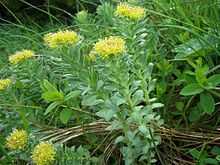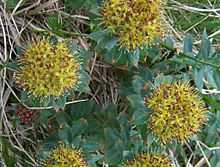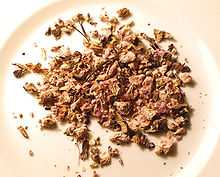Rhodiola rosea
| Rhodiola rosea | |
|---|---|
 | |
| Scientific classification | |
| Kingdom: | Plantae |
| (unranked): | Angiosperms |
| (unranked): | Eudicots |
| (unranked): | Core eudicots |
| Order: | Saxifragales |
| Family: | Crassulaceae |
| Genus: | Rhodiola |
| Species: | R. rosea |
| Binomial name | |
| Rhodiola rosea L.[1] | |
| Synonyms | |
|
Sedum rosea (L.) Scop. | |
Rhodiola rosea (commonly golden root, rose root, roseroot, western roseroot, Aaron's rod, Arctic root, king's crown, lignum rhodium, orpin rose) is a perennial flowering plant in the family Crassulaceae. It grows in cold regions of the world, including much of the Arctic, the mountains of Central Asia, scattered in eastern North America from Baffin Island to the mountains of North Carolina, and mountainous parts of Europe, such as the Alps, Pyrenees, and Carpathian Mountains, Scandinavia, Iceland, Great Britain and Ireland. It grows on sea cliffs and on mountains[2] at altitudes up to 2280 meters. Several shoots grow from the same thick root. Shoots may reach 5 to 35 cm in height. R. rosea is dioecious – having separate female and male plants.
Description
Rhodiola rosea is from 5 to 40 centimetres (2.0 to 15.7 in) tall, fleshy, and has several stems growing from a short, scaly rootstock. Flowers have 4 sepals and 4 petals, yellow to greenish yellow in color sometines tipped with red, about 1 to 3.5 millimetres (0.039 to 0.138 in) long, and blooming in summer.
Taxonomy
The first time that R. rosea is described was from Dioscorides in De Materia Medica.
Western North American plants formerly included in R. rosea are now treated as Rhodiola integrifolia and Rhodiola rhodantha.[3]
Uses

Some studies have found support for it having antidepressant effects.[4][5] It is not approved by the U.S. Food and Drug Administration (FDA) to cure, treat, or prevent any disease. In fact, the FDA has forcibly removed some products containing R. rosea from the market due to disputed claims that it treats cancer, anxiety, influenza, the common cold, bacterial infections, and migraines.[6]
R. rosea may be effective for improving mood and alleviating depression. Pilot studies on human subjects[7][8][9] showed it improves physical and mental performance, and may reduce fatigue.
In Russia and Scandinavia, R. rosea has been used for centuries to cope with the cold Siberian climate and stressful life. [10][11] Such effects were provided with evidence in laboratory models of stress using the nematode C. elegans,[12] and in rats in which Rhodiola effectively prevented stress-induced changes in appetite, physical activity, weight gain and the estrus cycle.[13]
The plant has been used in traditional Chinese medicine, where it is called hóng jǐng tiān (红景天). The medicine can be used to prevent altitude sickness.
The aerial portion is consumed as food in some parts of the world, sometimes added to salads.[14]
Phytochemicals and health effects

Research regarding R. rosea efficacy is contradictory. While some evidence suggests that the herb may be helpful for enhancing physical performance and alleviating mental fatigue, methodological flaws limit accurate assessment of efficacy. A rigorously-designed well reported RCT that minimizes bias is needed to determine true efficacy of R. rosea for fatigue.[15]
Scientists have identified about 140 chemical compounds in the subterranean portions of R. rosea.[16] Rhodiola roots contain phenols, rosavin, rosin, rosarin, organic acids, terpenoids, phenolcarbonic acids and their derivatives, flavonoids, anthraquinones, and alkaloids.
The chemical composition of the essential oil from R. rosea root growing in different countries varies. For example, rosavin, rosarin and rosin at their highest concentration according to many tests can be found only in R. rosea of Russian origin; the main component of the essential oil from Rhodiola growing in Bulgaria are geraniol and myrtenol; in China the main components are geraniol and 1-octanol; and in India the main component is phenylethilic alcohol. Cinnamic alcohol was discovered only in the sample from Bulgaria.[17]
Although rosavin, rosarin, rosin and salidroside (and sometimes p-tyrosol, rhodioniside, rhodiolin and rosiridin) are among suspected active ingredients of R. rosea, these compounds are mostly polyphenols. There is no evidence that these chemicals have any physiological effect in humans that could prevent or reduce risk of disease.[18]
Although these phytochemicals are typically mentioned as specific to Rhodiola extracts, there are many other constituent phenolic antioxidants, including proanthocyanidins, quercetin, gallic acid, chlorogenic acid and kaempferol.[19][20]

References
- ↑ "Rhodiola rosea - Plants For A Future database report". www.pfaf.org. Retrieved 2008-02-23.
- ↑ Stace, C.A. (2010). New flora of the British isles (Third ed.). Cambridge, U.K.: Cambridge University Press. p. 138. ISBN 9780521707725.
- ↑ Moran, Reid V,, in Flora of North America. volume 8. pages 164-167.
- ↑ Darbinyan V, Aslanyan G, Amroyan E, Gabrielyan E, Malmström C, Panossian A (2007). "Clinical trial of Rhodiola rosea L. extract in the treatment of mild to moderate depression". Nord J Psychiatry 61 (5): 343–8. doi:10.1080/08039480701643290. PMID 17990195.
- ↑ Dwyer AV, Whitten DL, Hawrelak JA (March 2011). "Herbal medicines, other than St. John's Wort, in the treatment of depression: a systematic review" (PDF). Altern Med Rev 16 (1): 40–9. PMID 21438645.
- ↑ See for example, Letter, dated April 21, 2005, Food and Drug Administration
- ↑ Shevtsov VA, Zholus BI, Shervarly VI et al. (Mar 2003). "A randomized trial of two different doses of Rhodiola rosea extract versus placebo and control of capacity for mental work". Phytomedicine 10 (2–3): 95–105. doi:10.1078/094471103321659780. PMID 12725561.
- ↑ Darbinyan V, Kteyan A, Panossian A, Gabrielian E, Wikman G, Wagner H (Oct 2000). "Rhodiola rosea in stress induced fatigue—a double blind cross-over study of a standardized extract with a repeated low-dose regimen on the mental performance of healthy physicians during night duty". Phytomedicine 7 (5): 365–71. doi:10.1016/S0944-7113(00)80055-0. PMID 11081987.
- ↑ Ha Z, Zhu Y, Zhang X et al. (Sep 2002). "[The effect of rhodiola and acetazolamide on the sleep architecture and blood oxygen saturation in men living at high altitude]". Zhonghua Jie He He Hu Xi Za Zhi (in Chinese) 25 (9): 527–30. PMID 12423559.
- ↑ Azizov, AP; Seĭfulla, RD (May–Jun 1998). "[The effect of elton, leveton, fitoton and adapton on the work capacity of experimental animals].". Eksperimental'naia i klinicheskaia farmakologiia 61 (3): 61–3. PMID 9690082.
- ↑ Darbinyan, V; Kteyan, A; Panossian, A; Gabrielian, E; Wikman, G; Wagner, H (Oct 2000). "Rhodiola rosea in stress induced fatigue--a double blind cross-over study of a standardized extract SHR-5 with a repeated low-dose regimen on the mental performance of healthy physicians during night duty.". Phytomedicine : international journal of phytotherapy and phytopharmacology 7 (5): 365–71. doi:10.1016/S0944-7113(00)80055-0. PMID 11081987.
- ↑ Wiegant FA, Surinova S, Ytsma E, Langelaar-Makkinje M, Wikman G, Post JA (Jun 2008). "Plant adaptogens increase lifespan and stress resistance in C. elegans". Biogerontology 10 (1): 27–42. doi:10.1007/s10522-008-9151-9. PMID 18536978.
- ↑ Mattioli L, Funari C, Perfumi M (May 2008). "Effects of Rhodiola rosea L. extract on behavioural and physiological alterations induced by chronic mild stress in female rats". Journal of Psychopharmacology (Oxford) 23 (2): 130–42. doi:10.1177/0269881108089872. PMID 18515456.
- ↑ Saratikov A.S. (1974). Golden Root (Rhodiola Rosea) (2nd ed.). Publishing House of Tomsk University. p. 158.
- ↑ Ishaque S, Shamseer L, Bukutu C, Vohra S (2012). "Rhodiola rosea for physical and mental fatigue: a systematic review". BMC Complement Altern Med (Systematic review) 12: 70. doi:10.1186/1472-6882-12-70. PMC 3541197. PMID 22643043.
- ↑ Panossian, A., Wikman, G. (2010). "Rosenroot (Roseroot): Traditional Use, Chemical Composition, Pharmacology, and Clinical Efficacy". Phytomedicine 17 (5-6): 481–493. doi:10.1016/j.phymed.2010.02.002.
- ↑ Evstavieva L., Todorova M., Antonova D., Staneva J. (2010). "Chemical composition of the essential oils of Rhodiola rosea L. of three different origins". Pharmacogn Mag. 6 (24): 256–258.
- ↑ Boudet AM (2007). "Evolution and current status of research in phenolic compounds". Phytochemistry 68 (22–24): 2722–35. doi:10.1016/j.phytochem.2007.06.012. PMID 17643453.
- ↑ Yousef GG, Grace MH, Cheng DM, Belolipov IV, Raskin I, Lila MA (Nov 2006). "Comparative phytochemical characterization of three Rhodiola species". Phytochemistry 67 (21): 2380–91. doi:10.1016/j.phytochem.2006.07.026. PMID 16956631.
- ↑ Liu Q, Liu ZL, Tian X (Feb 2008). "[Phenolic components from Rhodiola dumulosa]". Zhongguo Zhong Yao Za Zhi (in Chinese) 33 (4): 411–3. PMID 18533499.
External links
-
 Media related to Rhodiola rosea at Wikimedia Commons
Media related to Rhodiola rosea at Wikimedia Commons - Plants For A Future, Rhodiola rosea Rose Root PFAF
- Wilderness Medical Society, Lack of Effect of Rhodiola on Hypoxemia and Oxidative Stress